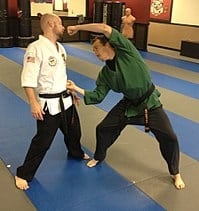
American Kenpo
American Kenpo Karate (), also known as American Kenpo and Kenpo Karate, is an updated system of martial arts based on modern-day street fighting that applies logic and practicality. It is characterized by the use of quick and powerful strikes delivered from all of the body’s natural weapons, powered by rapid stance transitions, called “shifting.” Beginners are introduced to basic attack responses, which comprise a larger system taught through scripted scenarios, which allow instructors a platform to share concepts and principles Ed Parker emphasized in his teachings.
The purpose of training in this manner is to increase physical coordination and continuity with linear and circular motion. Each movement, when correctly executed, leads into the next, keeping an adversary’s “dimensional zone” in check, while limiting their ability to retaliate. Should the adversary not react as anticipated, the skilled Kenpo practitioner, it is argued, is able to seamlessly transition into an alternative and appropriate action, drawn spontaneously from the trained subconscious.Founded and codified by Ed Parker, American Kenpo is primarily a self-defense combat system. Parker made significant modifications to the original art of Kenpo which he learned throughout his life, by introducing or changing principles, theories, and concepts of motion, as well as terminology. At the time of his passing in December 1990, Parker had created Short Form 1, Long Form 1, Short Form 2, Long Form 2, Short Form 3, Long Form 3, Long Form 4, Long Form 5 (Surprise Attacks), Long Form 6 (Bare Hands vs. Weapons), Long Form 7 (Twin Clubs), and Long Form 8 (Twin Knives). Parker also created 154 named (ideal phase) technique sequences with 96 extensions, taught in three phases (Ideal, What-if and Formulation Phases). Parker believed in tailoring Kenpo to the individual and would also encourage his students to explore the unknown areas of martial arts.
Parker left behind a large following of instructors who honored his teachings by implementing many different versions of American Kenpo. As Senior Grandmaster, Parker did not name a successor to his art, but instead entrusted his senior students to continue his teachings in their own way.
Read More About American Kenpo

